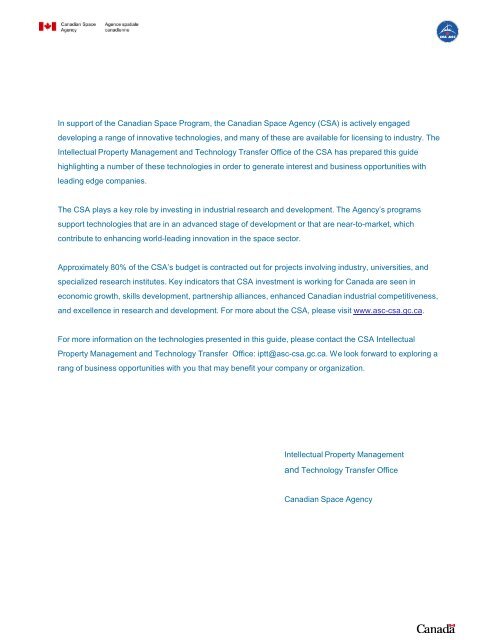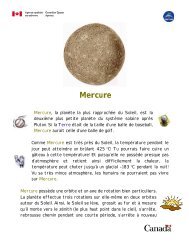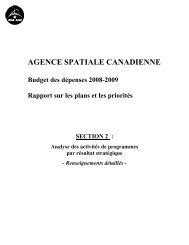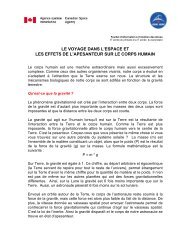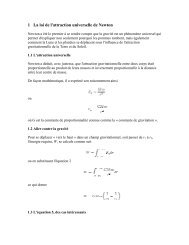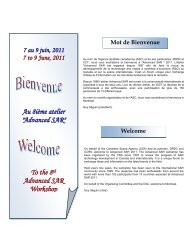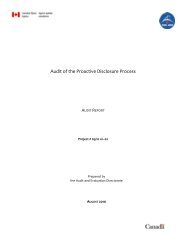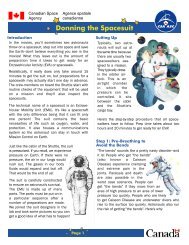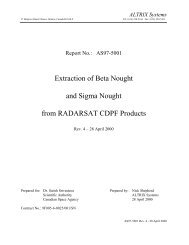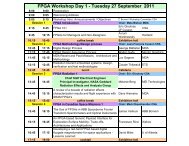PDF version (794 Ko) - Agence spatiale canadienne
PDF version (794 Ko) - Agence spatiale canadienne
PDF version (794 Ko) - Agence spatiale canadienne
- No tags were found...
You also want an ePaper? Increase the reach of your titles
YUMPU automatically turns print PDFs into web optimized ePapers that Google loves.
In support of the Canadian Space Program, the Canadian Space Agency (CSA) is actively engageddeveloping a range of innovative technologies, and many of these are available for licensing to industry. TheIntellectual Property Management and Technology Transfer Office of the CSA has prepared this guidehighlighting a number of these technologies in order to generate interest and business opportunities withleading edge companies.The CSA plays a key role by investing in industrial research and development. The Agency’s programssupport technologies that are in an advanced stage of development or that are near-to-market, whichcontribute to enhancing world-leading innovation in the space sector.Approximately 80% of the CSA’s budget is contracted out for projects involving industry, universities, andspecialized research institutes. Key indicators that CSA investment is working for Canada are seen ineconomic growth, skills development, partnership alliances, enhanced Canadian industrial competitiveness,and excellence in research and development. For more about the CSA, please visit www.asc-csa.gc.ca.For more information on the technologies presented in this guide, please contact the CSA IntellectualProperty Management and Technology Transfer Office: iptt@asc-csa.gc.ca. We look forward to exploring arang of business opportunities with you that may benefit your company or organization.Intellectual Property Managementand Technology Transfer OfficeCanadian Space Agency
The BusinessOpportunityComponents of a complexsystem are subject to possibleand probable faults duringoperation. A means ofidentifying a subset ofcomponents that most likelyinclude the faultycomponent(s) is required sinceit is impossible and impracticalto examine all systemcomponents. Probingtechniques are then required toidentify the exact faultycomponent(s) from thesuspected subset ofcomponents. The mainlimitation of traditionalapproaches is poor scalabilityto the number of componentsin the underlying system. Inaddition, traditionalapproaches suffer from highcomputational memory andprocessing usage.Instead of pure reliance onlogic reasoning (which ischaracteristic of traditionalapproaches), the inventionuses set operations forinference. The techniques arescalable to the number ofcomponents in the system andrequire very little memory andcomputational resources, withthe advantage of providinggreat commercial value.Inference Techniques for DiagnosisBased on Set OperationsThe TechnologyThe invention provides inference techniquesfor diagnosis based on set operations that aimto find a set of all possible faulty componentsin a complex system. It further attempts to findthe exact faulty component(s) through the useof probability-based fault probing. Thetechniques encompassed by the invention areapplicable to systems with low to a very highnumber of components and require very littlememory and computational resources.Commercial PotentialThe technology has commercial applicationsin any industry that includes the use ofcomplex systems that may have faultycomponents. Generally, these techniquesmay be applied to maintenance and testingapplications (or any application requiring faultdetection and isolation) within the automotive,aircraft and marine industries, medical andpharmaceutical fields and other manufacturingindustries.Within the armed forces and military, theinvention may have further applications incritical systems. The implementation may bedone in stand-alone software and hardware ormay be embedded in a health-monitoringmodule for complex army systems (e.g. tanks,unmanned air vehicles, jet fighters,helicopters).TechnologyTransfer DetailsA commercializationlicense for this technologyis available.The businessopportunity may bereferred to by itsCSA case ID: 50743CommercializationContactIntellectual PropertyManagement andTechnology TransferCanadian Space AgencyTel.: (450) 926-5800Fax: (450) 926-4613E-mail: iptt@asc-csa.gc.ca4
The BusinessOpportunityMany applications ofmanipulators depend on a highdegree of precision in positiontracking in spite of loaddynamics. The inventionaddresses this need byproviding a robust controlalgorithm capable of achievingprecise position trackingirrespective of load dynamics(e.g. link dynamics ofmanipulators, cutting force in aCNC machine tool, or windforce in a radar-trackingantenna). In order toaccomplish this, the inventionuses uncalibrated joint torquesensors without the need foran accurate link dynamicsmodel, which may or may notbe available.Adaptive Self-Tuning Controller ofManipulators Using Uncalibrated JointTorque SensingThe TechnologyThe invention represents an adaptive controllerfor robot manipulators that uses signalsreceived from joint torque sensors to adaptivelycompensate for the effects of robot linkdynamics. In particular, the invention uses aself-tuning control algorithm that adaptivelytunes the gains and offset of the torque sensorin addition to other parameters (includinginertia of the motor’s rotors, link twist angles,friction parameters of the joints, etc.), toachieve zero tracking error.Commercial PotentialThe technology has applications in areasrequiring high degrees of precision in positiontracking, including the following:• Arc welding;• Laser cutting;• Fixtureless assembly;• CNC machine tooling;• High-speed tracking and positioning servosystems for precision weapons;• Radar-tracking antennae; and• Missile interception systems.TechnologyTransfer DetailsA commercializationlicense for this technologyis available.The businessopportunity may bereferred to by itsCSA case ID: 50740CommercializationContactIntellectual PropertyManagement andTechnology TransferCanadian Space AgencyTel.: (450) 926-5800Fax: (450) 926-4613E-mail: iptt@asc-csa.gc.ca7
The BusinessOpportunityThe invention can be used toencode, browse, store, andtransmit any type of imagingspectrometry data (also knownas hyperspectral imagery),whether ground-based,airborne, or spaceborne.Because data is stored andprocessed in compressedform, the system provides foran abundance of imagingspectrometry datasets incombination with fastinformation and productsretrieval capabilities.Alternative systems do notprovide equivalent featuresand on-line access to largeimaging spectrometry datasetsacross wide-area networks.System for Interactive Visualization andAnalysis of Imaging SpectrometryDatasets over a Wide-area NetworkThe TechnologyThe invention has been patented in the UnitedStates (US Patent no. 6,546,146). Thetechnology allows users to interactivelyvisualize and analyze large imagingspectrometry datasets using a personalcomputer a connectivity package for a wideareanetwork (i.e. internet).Using a new "on-the-fly" compressionprocess, the technology reduces the volumeof the data by about 100 times. Users canselect, view and analyze imagingspectrometry datasets via a wide-areanetwork with almost no lag time thanks to theoperation being on the data in compressedform.TechnologyTransfer DetailsA commercializationlicense for this technologyis available.The businessopportunity may bereferred to by itsCSA case ID: 50344PatentsUS 6,546,146CA 2,253,145This invention is the onlyknown system to combineencoding, processing incompressed form for effectiveproduct retrievals, indexmapping, compressed datastorage, high-speed transfer,and rapid decompression,while empowering the user todetermine the usefulness of animaging spectrometry datasetvia wide-area networks beforeinvesting in it.Commercial PotentialPotential commercial application areasinclude earth observation, militarysurveillance, astronomy, microscopy,medicine (i.e. medical imaging systems), andcharacterization of materials (i.e. materialscience). There may also exist applications inforensic and general medicine. Thetechniques of the invention may be applied toimaging spectrometers that are used inabsorption or reflection spectroscopy,fluormetry, and energy transfer diffractometry.Further applications of these techniquesinclude process control and energy-dispersivetomography.CommercializationContactIntellectual PropertyManagement andTechnology TransferCanadian Space AgencyTel.: (450) 926-5800Fax: (450) 926-4613E-mail: iptt@asc-csa.gc.ca8
The BusinessOpportunityZero-G Emulating Test Bed for SpacecraftAttitude/ Translation Control SystemThe TechnologyIn the aerospace industry,there is a well-defined need totest and verify spacecraftattitude/translation controlsystems while all componentsare integrated. The risksassociated with faultycomponents and the faultyintegration of such a complexsystem is high. Failure iscostly.This zero-gravity emulatingtest bed can provide anefficient facility for verificationand testing of a spacecraftcontrol system after allcomponents have beenintegrated.9This technology is used for zero-gravity emulation of aspacecraft in an Earth laboratory environment (1 g)using a controlled manipulator which holds a flightspacecraft or satellite. The control system changes thedynamic behaviour of the spacecraft to emulate thebehaviour of the targtesting et spacecraft in orbit. Suchan arrangement also makes it possible not only to beable to scale the inertia of the testing spacecraft, butalso to create the motion perturbation induced by theflexible element of flight spacecraft, even if testspacecraft lack such elements.Commercial PotentialThe greatest challenge in implementing a controlsystem for spacecraft is that ground-basedtesting must take place in a 1-g environment,whereas the eventual hardware will operate in azero-g environment. Present research showsthat this innovation is of vital importance to beable to test and validate the system performanceunder realistic conditions and through maximumusage of hardware. This technology has thepotential to significantly improve the reliability ofoperational performance of satellite attitude/translation control systems in-orbit.Adoption of the invention could confercomparative, competitive advantages byimproving the design and effectiveness ofterrestrial testing of satellite attitude/translation control systems.A receptor company could apply this technologyto: testing attitude control systems (ACS) ofcommercial satellites; investigating thedisturbance effect of a deployment mechanism(e.g. solar panel or antenna) of commercialsatellites; and testing the gas-jet propulsionsystem and translation control system of freeflyinginspection robots, constellation satellites,and orbital formation satellites.TechnologyTransfer DetailsA commercializationlicense for this technologyis available.The businessopportunity may bereferred to by itsCSA case ID: 50689CommercializationContactIntellectual PropertyManagement andTechnology TransferCanadian Space AgencyTel.: (450) 926-5800Fax: (450) 926-4613E-mail: iptt@asc-csa.gc.ca
The BusinessOpportunityThe need for new actuators inrobotics and automation ispervasive. However, any newlydeveloped actuator mustundergo extensive mechanical,electrical, control and thermaltests. Currently, actuator testscan be performed on a robotprototype built with the newlydeveloped actuators. However,the prototyping process isexpensive, inflexible, and notapplicable for space robots, assuch robots do not operate inthe thermal and gravityconditions of Earth.This invention is designed for aspecialized test-bed facility thatdevelops and testselectromechanical actuatorsfor robotics and automationapplications. Its designinnovations allow for lessexpensive and more costeffectivedevelopment andtesting of actuators.Dynamometer with Active Load forTesting Manipulator's Joint PrototypesThe TechnologyA product derived from this invention could beused as a development tool for manufacturersof electromechanical actuators for roboticsapplications, in various industrial sectors. Themechanical load of a mechatronics systemcan be replaced with an active load systemand the actuators of a mechatronics systemcan be tested before the rest of themechanical system is fabricated.Commercial PotentialThe demand for development of newactuators for mechatronics systems isestablished and growing. Yet prototyping ofthe complete system for testing is often anexpensive and inflexible process. A productderived from this invention would be a costeffectivereplacement for traditionalprototyping.This invention is designed for a facility fortesting space or terrestrial robot actuatorsunder their end-use thermal and mechanicalconditions. Unlike the conventionaldynamometer, which has a brake to applyfriction torque, this invention uses active loadthat generates the torque dynamics of a targetmanipulator.TechnologyTransfer DetailsA commercializationlicense for this technologyis available.The businessopportunity may bereferred to by itsCSA case ID: 50706CommercializationContactIntellectual PropertyManagement andTechnology TransferCanadian Space AgencyTel.: (450) 926-5800Fax: (450) 926-4613E-mail: iptt@asc-csa.gc.ca10
The BusinessOpportunityThe overload capacity of thecommercial load cell is nothigh enough for manyindustrial and laboratoryapplications. Therefore, inpractice, an oversized sensoris used to increase the marginof overload safety. However,the larger sensors are usuallyless accurate.This invention has an overloadcapacity several times that of asensor. This is its competitiveadvantage. It could ensure thatsensors will not break whenoverloaded and that load cellsdo not require recalibration orreplacing after overloadtesting.Design of a Load Cell with LargeOverload CapacityThe TechnologyLoad cells (force sensors) are fragile devices.Commercially available load cells generallyhave an overload capacity up to one and ahalf times full-scale range. Exceeding this limitdamages the sensor structure. This load cellprovides large overload protection capacitywithout compromising the sensitivity oraffecting the characteristics of the sensor. Aspecial design feature is that it becomesvirtually rigid after the sensor flexures reachtheir maximum deflection.Commercial PotentialThis sensor features high stiffness and goodextraneous load rejection that makes it idealfor robotic laboratories. It is mainly for thesingle-point load cell type.Commercial load cells are widely used in theaerospace, agriculture, automotive, aviation,construction, forestry, freight transportation,maritime, mining, and waste managementmarkets. These devices are embedded inindustrial-weighing and materials-handlingequipment in dynamic and stationary weighingsystems, load-handling and moving systems,measurement devices, instrumentation, andoperations control and information systems.TechnologyTransfer DetailsA commercializationlicense for this technologyis available.The businessopportunity may bereferred to by itsCSA case ID: 50705CommercializationContactIntellectual PropertyManagement andTechnology TransferCanadian Space AgencyTel.: (450) 926-5800Fax: (450) 926-4613E-mail: iptt@asc-csa.gc.ca11
The BusinessOpportunityIn practice, it is difficult tocontrol a hydraulic actuatorprecisely—and, thus, also amechatronic system—becausethe force/torque generated bythe actuator is affected by theactuator's own motion and thatof the load. This technologyinnovation allows rotary andlinear hydraulic actuators togenerate a precise amount oftorque, regardless of theactuator motion.Commercial hydraulicactuators incorporating theinvention will improve inperformance significantlywhere high torque/force andprecise control are required,such as in industrial roboticsand automation. In certainapplications, this inventionwould have a competitiveadvantage over existinghydraulic actuators in themarketplace.Identification and Torque/Force Controlof Hydraulic ActuatorsThe TechnologyThis invention employs sensors to measureselected physical variables of an operatinghydraulic actuator for identification and controlpurposes. The commercial product derivedfrom this invention would use a hydraulicactuator with additional sensors (that is, apressure transducer and motion sensors tocapture position and velocity) and a controllerwith embedded proprietary software. Theactuator would be part of an industrial systemwith sufficient onboard processing hardwareto accommodate the controller.Commercial PotentialThis technology is a combined scheme ofidentification and torque control for rotaryhydraulic actuators. It can readily be appliedto linear hydraulic actuators.Hydraulic actuators are widely used inindustrial applications such as roboticmanipulators, forestry, earth moving, mining,material handling, construction sites, andmanufacturing automation where large powerto-massratio is required.TechnologyTransfer DetailsA commercializationlicense for this technologyis available.The businessopportunity may bereferred to by itsCSA case ID: 50719PatentsUS 7,403,826CommercializationContactIntellectual PropertyManagement andTechnology TransferCanadian Space AgencyTel.: (450) 926-5800Fax: (450) 926-4613E-mail: iptt@asc-csa.gc.ca12
The BusinessOpportunityCanadian Space Agencyengineers have developed aninnovative method for theemulation of electricalactuation by using hydraulicactuators for robotic systems.From this invention acommercial product could becreated that has a controlalgorithm, including a softwarepackage. It also offers asophisticated parameter tuningprocedure for adaptive controlof hydraulic actuators andancillary equipment for roboticapplications.It can be used to significantlyincrease the output forcecontrol performance ofhydraulic actuators bycompensating 95% of thepiston friction. It hasapplications for both freemotionand contact tasks.Adaptive Output Force Control ofHydraulic CylindersThe TechnologyCommercial hydraulic actuator testingsystems are available and in-house designedhydraulic testing systems are employed in theindustry. Furthermore, test beds for hydraulicactuators have been developed for researchpurposes in universities. However, thesecommercial and research test systems do notseem to use an approach based on theadaptive output force control of hydrauliccylinders. This technology establishes thedynamic equivalency between electricallydriven motors and hydraulically drivencylinders.Commercial PotentialThe demand for hydraulic actuators is wellestablished and growing. They are used in avariety of industrial applications.The product derived from this innovation maybe in the form of a software module togetherwith a sophisticated parameter tuningprocedure; it would be implemented by theend-user within the user's test facility.Alternatively, it could be a fully functional testbed with load sensors, electronic cabling,microprocessors, displays, software and,ancillary mechanical elements. This test bedcould support and drive the actuator duringtesting and automatically implement thetesting procedures.TechnologyTransfer DetailsA commercializationlicense for this technologyis available.The businessopportunity may bereferred to by itsCSA case ID: 50699CommercializationContactIntellectual PropertyManagement andTechnology TransferCanadian Space AgencyTel.: (450) 926-5800Fax: (450) 926-4613E-mail: iptt@asc-csa.gc.ca13
The BusinessOpportunityAdaptive Control of Harmonic DrivesHarmonic drives are widelyused in robotic applicationsdue to their compactness andease of use. However,performance is always limitedbecause of friction andflexibility issues.This innovative adaptivecontroller is able to take intoaccount the flexsplinedynamics, to compensate forthe friction, and to handle theuncertainties of dynamicparameters simultaneously. Itwould confer competitiveadvantage to a harmonic drivemanufacturer with its improvedmotion and torque controlperformance, particularly fordemanding roboticapplications.The TechnologyThe innovation significantly improves thecontrol performance of harmonic drives byusing a proprietary control algorithm (i.e.,software and a sophisticated parameter tuningprocedure) together with a flexspline torquesensor. The conventional adaptive controlleris modified to use torque sensormeasurements and has been tested on fourtypes of harmonic drives.This technology can be easily incorporated inmotion/force control of robot manipulatorsbased on either the torque control interface orthe virtual power flow principal that defineseach dynamic coupling between a joint and arobot.Commercial PotentialVarious technologies are currently used tocontrol harmonic drives in industrialapplications. Each of these technologies haslimitations that result in imperfect roboticmotion control performance.This invention offers a competitive controlsystem for harmonic drives that are used inrobotics and mechatronic systems.Harmonic drives are used to control motion inapplications requiring precise positionalaccuracy and repeatability, such as inprecision machining, factory automation,robotics, and aerospace applications.TechnologyTransfer DetailsA commercializationlicense for this technologyis available.The businessopportunity may bereferred to by itsCSA case ID: 50718CommercializationContactIntellectual PropertyManagement andTechnology TransferCanadian Space AgencyTel.: (450) 926-5800Fax: (450) 926-4613E-mail: iptt@asc-csa.gc.ca14
The BusinessOpportunityEmulating robots arerequired to verify thefunctionality of robotsperforming contact tasks inharsh environments.Control of the emulatingrobot is very challenging; itrequires matching thecontact force frequencyresponseof the emulatingrobot and that of the actualrobot, attenuating sensitivityto force sensor noise, whilemaintaining contact stabilityin spite of uncertainenvironmental impedanceand inaccurate emulatingrobot dynamics model.This technology is availablefor license and serves tooptimally change theimpedance of a robot to anydesired compleximpedance (e.g., that of aflexible space robot) whileensuring contact stability fora class of prescribedenvironments. Such animpedance control methodcan be applied to a highfidelityemulating robotsystem where the objectiveis to assign a prescribedimpedance to the emulatingrobot.A Robust-Performance Approach toImpedance-Matching of RobotsInteracting with Unknown EnvironmentsThe TechnologyThis invention represents the development of amethod to emulate a target robot operating in acomplex environment with the use of an actualrobot. The actual robot serves to replicate thedynamic behaviour of the target robot withoutrelying on complex contact dynamiccalculations. Experimental results havedemonstrated the invention to achieve robustperformance.Commercial PotentialThe emulation method described by the subjectinvention may have commercial application inthe validation of robots working in harshenvironments, such as space and undersearobots. In addition, military applications mayinclude control of mine-defusing robots andemulation of undersea robotic arms, remotelyoperated vehicles, and docking satellites.Retrofitting the proposed impedance controllerinto existing industrial robots is expected togenerate improved robustness andperformance.TechnologyTransfer DetailsThe businessopportunity may bereferred to by itsCSA case ID: 50748PatentsUS 7,688,016CommercializationContactIntellectual PropertyManagement andTechnology TransferCanadian Space AgencyTel.: (450) 926-5800Fax: (450) 926-4613E-mail: iptt@asc-csa.gc.ca15
The BusinessOpportunityBoth the remote sensingand medical imagingmarkets recognize the needfor high image quality toimprove the usefulness ofimagery. As such,commercial applications ofthe technology includeenhancing raw imagerydata processing, providingcustomized data processingservices to end-users, andenhancing image quality inmedical imaging.This technology is availablefor license and provides ameans for achieving highersignal-to-noise ratiorequirements (e.g. elevateSNR in the range of 500:1to 1000:1), which mayresult in sales of new andarchived imagery data forremote sensing imageryreceptors. In addition, theinvention will provide forincreased clarity and imagedefinition for medicalimaging equipment andsoftware receptors.Method and System of Increasing Signal-To-Noise Ratio of Multi-Dimensional DataThe TechnologyThis invention comprises proprietarytechniques to improve the signal-to-noise ratio(SNR) of multi-dimensional data (i.e. datacubes) by removing noise in the data. It hasbeen applied to increasing the signal-to-noiseratio (SNR) of acquired hyperspectralimageries for improving remote sensingapplications. This invention can also be used toareas where increasing SNR of multidimensionaldata is demanded, such as,3-dimensional medical imagery. Thetechniques are implemented in software usingconventional programming tools.In some applications the invention may includespecialized hardware to accommodate highperformance computation. At this stage ofproduct development the invention comprisesonly the software component and additionaleffort is required to design and optimizeauxiliary high performance computationalhardware.Commercial PotentialThe invention has commercial potential inapplications of optical, radar and other form ofimages. The invention can improve the SNRand data usefulness for commercial end-usersin government (surveillance), university, andindustry (i.e. agriculture, mining, and forestry).The invention can also improve the SNR in 3Dmedical imaging applications (i.e. MRI, positronemission topography, enhanced ultrasound andcomputed tomography modalities), resulting insharper images.TechnologyTransfer DetailsThe businessopportunity may bereferred to by itsCSA case ID: 50769CommercializationContactIntellectual PropertyManagement andTechnology TransferCanadian Space AgencyTel.: (450) 926-5800Fax: (450) 926-4613E-mail: iptt@asc-csa.gc.ca16
The BusinessOpportunityIn rigid contact robotapplications it is verydifficult to achieve forcecontrol for tip contactwith a solid surface orother features such ascorners where there issudden change indirection. The inventionprovides a smoothercontact and continuousgrasping of the rigidtarget by the robot.This technology isavailable for licensing.There is an opportunityfor this invention toimprove the hapticinterface performance insurgical simulations.Also, existingmanufactures of surgicalrobots with hapticinterfaces may be able toincorporate the inventioninto their existing systemto improve the tactileexperience by thesurgeon.Velocity Estimation by Using ImperfectAccelerometer and Encoder for RigidContact Modeling and ControlThe TechnologyAccurate estimation of end effector velocity iscritical in robotic applications involving highbandwidth modeling and control. The inventioncomprises two approaches for accurate velocityestimation, namely (1) two-channel approachand (2) observer-based approach, by usingaccurate position measurements andinaccurate acceleration measurements. Astandard encoder and a solid-stateaccelerometer are required for theimplementation. The signals from thesedevices are combined in the robot controllerand processed using the proprietary algorithm(including the gain and offset parameteradaptation), which can be readily embeddedinto generic robot controller software.Commercial PotentialThe invention has application in both modelingand real-time control of robots where highfrequency components of the velocity arerequired to perform accurate simulation andcontrol. The most commercially attractiveapplication for the invention is in haptic devicesfor surgery and related teleoperations. Theinvention would allow these devices to achievea higher degree of haptic fidelity and forcecontrol. Potential users for this inventioninclude manufacturers of haptic interfaces forrobot-assisted surgical procedures and forsimulation and surgical training.TechnologyTransfer DetailsThe businessopportunity may bereferred to by itsCSA case ID: 50779CommercializationContactIntellectual PropertyManagement andTechnology TransferCanadian Space AgencyTel.: (450) 926-5800Fax: (450) 926-4613E-mail: iptt@asc-csa.gc.ca17
Patented TechnologiesThe Canadian Space Agency owns a number of technologies not described in this guide that arepatented in Canada and the United States. Copies of the patents are available from the CanadianIntellectual Property Office and the United States Patent and Trademark Office.Some of these technologies may already be licensed to companies. Therefore, please contact theCSA Intellectual Property Management and Technology Transfer (IPM&TT) for more informationabout available licenses: IPTT@asc-csa.gc.ca.Technologies patented in CanadaProtection title Issue date Canadianpatent numberPressure sensor based on illumination 22/06/2004 2,226,137System and method for modulating a carrier frequency 16/12/2003 2,165,420Topological and motion measuring tool 02/12/2003 2,284,085Interface for orbital replacement units 06/05/2003 2,069,425Vision system and proximity detector 08/04/2003 2,195,359Advanced ship autopilot system 01/02/2005 2,367,690Soft docking interface 19/02/2008 2,177,204Rotating torque sensor 19/05/2007 2,153,118Coupling and robotic engagement fixture and jaws 25/10/2005 2,147,654System for interactive visualization and analysis of imagingspectrometry datasets over a wide-area networkMechanism for control of position and orientation in threedimensions12/12/2006 2,253,14501/01/2002 2,176,89918
Technologies patented in the United StatesProtection title Issue date U.S. patentnumberMethod and system for compressing a continuous data flowin real-time using recursive hierarchical self-organizingcluster vector quantization (HSOCVQ)System and method for encoding multidimensional datausing hierarchical self-organizing cluster vector quantization28/09/2004 6,798,36020/04/2004 6,724,940A time/motion compensation engine for HMDs 25/12/2007 7,312,766Sequential colour visual telepresence system 19/02/2008 7,333,156System and method for modulating a carrier frequency 07/01/1997 5,592,131Interface for orbital replacement units 14/11/1995 5,466,025Data compression engines and real-time widebandcompressor for multi-dimentional data31/07/2007 7,251,376Protein crystal growth facility (PROTECC) 27/02/2007 7,182,810Identification and torque/force control of hydraulic actuators 22/07/2008 7,403,826Rotational torque sensor 07/10/1997 5,675,095Four-degree-of-freedom manipulator 07/10/1997 5,673,595Tether and foot restraining device, securing handrail bracket 07/03/1995 5,395,083Bifurcated, orbital replacement unit interface 17/10/1995 5,458,384Article converging/diverging, chamfered walls gripping anvils 27/02/1996 5,494,325Soft docking interface 08/09/1998 5,803,751System and method for encoding/decoding multidimensionaldata using successive approximation multi-stage vectorquantization02/03/2004 6,701,02119
Protection title Issue date U.S. patentnumberMethod and apparatus for automatically inoculating culturemedia with bacterial specimens from specimen containers09/09/2003 6,617,146Advanced ship autopilot system 26/08/2003 6,611,737Distance tracking control system for single passtopographical mapping13/05/2003 6,563,130Topological and motion measuring tool 13/05/2003 6,563,107System for interactive visualization and analysis of imagingspectrometry datasets over a wide-area networkIntrinsic console with positionable, programmable, multifunction,multi-position controllers08/04/2003 6,546,14625/03/2003 6,538,637Mid-spatial frequency digital boost filter 22/01/2002 6,341,181Topological and motion measuring tool 03/10/2000 6,127,672Satellite attitude sensor using thermal imaging* 23/05/2000 6,066,850Pressure sensor based on illumination of a deformableintegrating cavityMechanism for control of position and orientation in threedimensions29/06/1999 5,917,18008/12/1998 5,847,528System and method for modulating a carrier frequency 07/01/1997 5,592,131Robust Impedance-Matching of Manipulators Interacting withUnknown EnvironmentsMethod and System for Compressing a Continuous DataFlow in Real-Time Using Cluster Successive ApproximationMulti-stage30/03/2010 7,688,01623/06/2009 7,551,78520* This patent is jointly owned by the Canadian Space Agency, Centre for Research in Earth and SpaceTechnology, and Thomson-CSF Optronics Canada, Inc.


